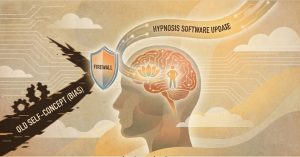Meditation and hypnosis share many parallels but are fundamentally different in many ways. Unarguably, heightened relaxation and enhanced awareness are common themes which are achieved through altered states of consciousness in both modalities. Below, we’ve outlined the similitudes and differences between meditation and hypnosis:
- Heightened States of Consciousness:
- Both meditation and hypnosis involve heightened states of consciousness. Whether you’re in a hypnotic induction or in a deep mediative state, you can expect to feel a sense of relaxation, intensified focus, and optimal suggestibility for your subconscious.
- Enhanced Attention:
- In both hypnosis and meditation, there is one unanimous goal; to amplify our attention in order to better dictate where that attention goes. Meditative practices incorporate more breath work, reciting mantras or zeroing in on a specific focal point, whereas in hypnosis, visualization, imagination and guided imagery are more prevalent for enhancing attention.
- Limited Outside Awareness:
- When we are deep in a meditative or hypnotic state, we experience far less awareness of external stimuli. They differ in that with meditation, we are more often practicing an introspective approach and directing focus on internal experiences. In hypnosis, our attention is typically diverted away from the external environment.
- The Relaxation Response
- Hypnosis and meditation are both implemented with the intent of achieving peace, tranquility and serenity. Thus, both modalities aim to elicit the relaxation response, leading to reduced stress and tension overall. In meditation, we relax for the purpose of achieving a state of inner calmness. But in hypnosis, relaxation is the foundational step for achieving heightened suggestibility in order for the real work to be done through the subconscious.
- Suggestibility of The Subconscious Mind:
- The main component that differentiates hypnosis from meditation is that it involves an element of suggestion, where the hypnotherapist feeds messages containing positive suggestions for behavioral change or anxiety management. Hypnosis messaging is tailored specifically to the client and conducted in a live setting, whereas in meditation, nothing is personal; these are general messages applicable to any audience on the receiving end.
- Intent & Purpose:
- Meditation and hypnosis are used for different intents and purposes. Meditation places priority on inner-peace and spiritual growth. Hypnosis however, is used for therapeutic purposes and with the objective of problem-solving. Hypnosis targets bad habits, fears and phobias, anxiety and stress management, or overcoming traumas. Meditation is more general, hypnosis is more specific.
Though there are notable similarities between meditation and hypnosis, it’s clear that they are completely different modalities with varying historical origins and cultural applications. Meditation attracts a more general audience as it embodies a more conventional methodology, while hypnosis is utilized in therapeutic and clinical settings as a way to rectify undesirable thoughts and behaviors.
















